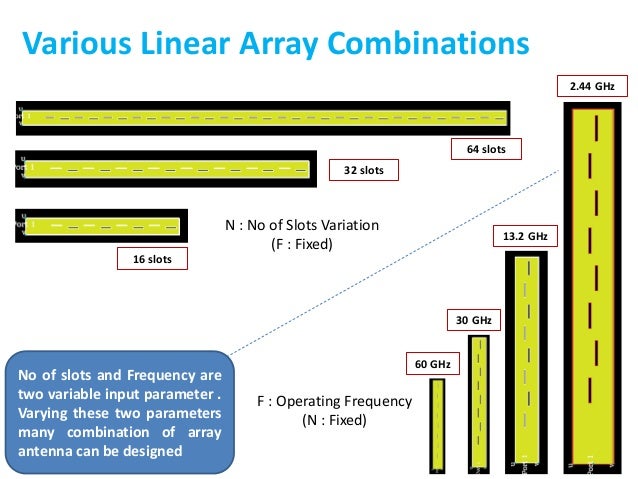Waveguide Slot Array Antenna Design
The presently constructed edge- wall slotted waveguide array antenna has dimensions of 1800 mm 150 mm 150 mm, including the metal flare and the feed network. The array consists of seventy one regularly spaced inclined slots along the edge wall of a rectangular guide. Each excitation element has a width of 1.8 mm and a resonant length.
This example shows how to analyze the performance of a slotted waveguide antenna.
Define parameters and Create a slotted waveguide
- 5.6 1x4 dielectric loaded modified horn slot antenna array fed by coaxial-cable 68 5.7 Comparison of far field radiation patterns for the 1x4 array excited using partial rectangular waveguide and coaxial cable at 23GHz 69.
- The design of the slotted waveguide array antenna is a fairly complicated task. It requires including an influ- ence of the internal (by a supplying slots waveguide) and the external (through the open space) mutual coupling between radiating slots on a radiation pattern.
Longitudinal Linear Traveling Wave Slotted Waveguide
The array consists of radiating slots of different electrical lengths. Due to inherent property, each of them will resonate at their own individual resonance frequency. If the slot length and positions are chosen in such a way that the lower cut-off frequency and higher cut-off frequency of the nth slot overlaps with the higher and lower cut-off frequencies of the (n-1)th and (n+1)th slots respectively, then the complete array is expected to give a wide band response resulting in log-periodic dipole array. Slot Offset on broad wall slots are parallel to the waveguide centerline and they are blocking the transversal current components on the waveguide's broad wall. The polarization of these slots is vertical when the waveguide is held parallel to the ground and the transversal current component is zero on the centerline of the broad wall, however, if one slot moves closer to the narrow walls, the transversal current component increases. Therefore, the radiation amplitude of these slots increases as they move away from the centerline and that is why they are called offset slots. This is the most widely used slot type and this design is taken from [1].
Plot Reflection Coefficient
Plot the reflection coefficient for this antenna over the frequency band of 10GHz to 12GHz and a reference impedance of 50 ohms.
Radiation pattern
The most significant effect to be considered in the design process are internal and external mutual coupling between slots. The internal mutual couplings are caused by the partial reflections of the incident electromagnetic wave from succeeding slots in a waveguide. These partial reflections cause a considerable displacement of the EM field inside the waveguide.

Create custom slots in waveguide
a) Transverse Slots array
Transverse slots result in a very high value of their normalized resistance and they cannot be matched to the characteristic waveguide impedance. So, they have no practical importance.
b) X shape slots creation
The cross(X) slots can generate a circular polarized wave with a good axial ratio performance. The slots are oriented to form an orthogonal pair of slots which eventually generate a circular polarized wave. The theory of cross slots also suggests that the slots should be ideally equal to half of the free space wavelength.
Conclusion
The models of the Slotted waveguide antenna have been built and analyzed and agree well with results reported from [1].
References
1. Montesinos Ortego, 'Contribution to the design of waveguide fed compound slot arrays by means of equivalent circuit modeling'
2. Zunnurain Ahmad,'Design and Implementation of Quasi Planar K-Band Array Antenna Based on Travelling Wave Structures'
Slotted antennas, a complement to dipole antennas, have slots a λ/2 long and a fraction of a wavelength wide. The antenna propagates based on Babinet’s principle of a resonant radiator. The key difference between a dipole and a slotted antenna is the field components are interchanged in orientation. Because of the vertical electric field in horizontal orientation, slot arrays can fit on the surface of moving objects without introducing much aerodynamic drag and wind load. For the same size, slotted waveguide array antennas are more efficient than any other planar antenna. Versatility in slot feeding options, ease of weather-proofing and mechanical stability make slotted antennas well-suited for military and defense applications.
For radar and communication systems, Eravant, formerly SAGE Millimeter, has developed the SAW-3533532716-28-L2-WR, a slotted waveguide array antenna operating at 35 GHz with 500 MHz bandwidth. The bandwidth can be increased by increasing the slot width, with cross-polarization increasing as a trade-off. The SAW-3533532716-28-L2-WR slot array supports linear, vertically polarized signals with high aperture efficiency and low VSWR. The antenna has 27 dBi gain with a half-power beamwidth of 16 degrees in the E-plane and 2 degrees in the H-plane. A radome of LEXAN polycarbonate makes the antenna suitable for outdoor applications. Its 1 lb. weight and small size - measuring 11.84 in. x 3.85 in. and just 0.93 in. thick - eases mounting and minimizes the dynamic load to the overall structure. A groove for an O-ring in the standard WR28 waveguide flange (UG-599/U) pressure seals the connecting interface. Integrating the antenna with a T/R diplexer, a dual channel I/Q receiver and an oscillator makes a complete package for many system applications, such as traffic management, law enforcement, communications and military surveillance.
The slot array antennas offered by Eravant span WR90 to WR10 and are designed with MIL-F-3922 designated standard flanges as the microwave connector interface.
Waveguide Slot Array Antenna Designs

Circular Waveguide Antenna
Eravant, formerly
SAGE Millimeter
Torrance, Calif.
www.eravant.com